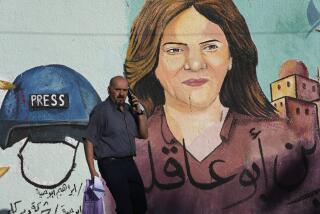French Army Course Aims to Teach Reporters How to Survive a War : Journalism: Lessons include how to spot a sniper, first aid and evasion techniques.
- Share via
COLLIOURE, France — Exploding grenades shake the air and machine guns chatter. Journalists scramble through a smoky maze of blackened buildings, a sewer and passageways filled with tear gas.
“There’s gunfire over that wall! Stay low!” one reporter yells to his colleagues.
It is a surreal war zone atop a 19th-Century fortress overlooking this Mediterranean port near the Spanish border. It also is make-believe.
In a three-day program at the French army’s National Commando Training Center, journalists learn how to adjust to warfare and avoid becoming statistics.
Last year, 63 journalists were killed around the world, many in combat zones, according to the French organization Reporters Without Borders.
“A press card or white paint on a U.N. vehicle are no longer enough,” said Lt. Col. Jean-Paul Legras, commander of the center.
“We want to show you little things that won’t protect you, but will make you less vulnerable,” Legras said in greeting the fourth class of the year-old program. “This has nothing to do with ‘Rambo.’ ”
His center normally operates courses of two to four weeks for army officers and French Legionnaires. The brief session for reporters includes avoidance of snipers, mines and booby-traps, lethality of weapons, first aid and basic hand-to-hand evasion techniques. The only charge is about $60 to cover food.
The French Defense Journalists’ Assn. asked the army for the program, similar to one in Australia.
“During the Gulf War, we had trouble working with the military, and Yugoslavia was an emerging war zone,” said Stefan Ciezka, the association’s treasurer.
Much of the instruction involves common sense, reminding everyone to be alert and resourceful. During sniper instruction, the class sat outside a two-story house while the trainer pointed out possible sniper nests.
“The most likely spot is the roof,” Lt. Michel Marzoc said. Then a commando sprang out through a skylight, submachine gun blazing with blanks, startling the pupils.
Look out for any opening in a house, from a chimney to a ground-level vent, journalists are told. In a high-rise, the choice spot is an upper floor--but not the top, an obvious target for sniper-hunters.
Wear dull or dark clothing, but if you choose green, “don’t complain you were mistaken for a soldier,” one instructor said. “And don’t carry army rations.”
Instructors showed how, through teamwork, two reporters could quickly pull each other through a window or drag a wounded comrade to safety. Using a smoke bomb for cover, the victim clasps his hands around the neck of the rescuer, who crawls on all fours.
When looking for a hide-out, push open a door slowly because it could be booby-trapped, the soldiers warned. The journalists practiced, carrying a block of wood in the shape of a video camera.
In a final test, students, alone or accompanied by commandos, negotiated a maze of buildings and alleys while soldiers shot blanks and exploded grenades at a safe distance. Reporters drove through a checkpoint manned by “drunken” fighters.
The most chilling part of the course displayed mines, other booby-traps and slides of maimed victims. Millions of anti-personnel mines, which cost as little as $1.50 each and can look as benign as a tuna can, are scattered in current or former combat zones around the world.
First-aid techniques taught in the course include treatment for shock and bleeding, mouth-to-mouth resuscitation and making stretchers and splints from available materials. Students practice using hypodermic needles on themselves.
At the nearby Mont Louis commando base in the Pyrenees, the class watched commandos fire rifles, machine guns and an antitank missile. Bullets went through wooden blocks and hollow brick walls, but were stopped by sandbags, walls of poured concrete and, surprisingly, tightly bound stacks of magazines.
By agreement with the journalists’ association, there will be at least one session in September and two more next year, Ciezka said.
The training does not always instill confidence. A German TV cameraman who filmed it said the course “reinforced my feeling never to cover a war zone.”
More to Read
Sign up for Essential California
The most important California stories and recommendations in your inbox every morning.
You may occasionally receive promotional content from the Los Angeles Times.













